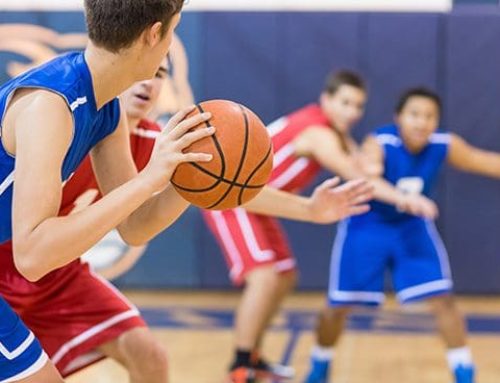The Simple Hack That Instantly Increases Your Vertical Jump
Impressive leaping ability is one of the most desirable traits in athletics.
From dunking a basketball to winning headers on the soccer pitch, the ability to jump high shows up on the scoreboard. It’s no wonder improving Vertical Jump performance is a desired outcome when training for sports like basketball, volleyball, football, and soccer.
Olympic lifts and Depth Jumps are typically programmed to increase jumping prowess and for a good reason. They work. Still, developing a bigger vertical jump via systematic training often takes weeks or months. What if there was a way to instantly jump higher without lifting weights or performing a six-week cycle of advanced plyometric drills?
How to Jump Higher Within Seconds
Remember when you and your buddies used to leap up and attempt to touch the bottom part of the backboard in elementary gym class? Little did your 11-year-old self know that an extrinsic motivator is a proven way to add some height to your hops. Basically, jumping for a target beats jumping without one.
A 2005 study published in the Journal of Strength and Conditioning Research examined the effects of an overhead goal on Vertical Jump height and movement biomechanics in collegiate athletes. Two D1 soccer teams (including 17 men and 18 women) performed Depth Jumps off a 31-centimeter (about 12 inches) box. Upon landing, the athletes were instructed to jump as high as possible on six different occasions. Three of the maximal Depth Jump trials involved no overhead goal. During the other three, a suspended ball—set to each trainee’s previously measured maximal Jump height—was placed directly above the athlete as a target to increase level of effort. The athletes were told to grab the ball with both hands at the top of their Jump.
Three things jump out when looking at the study results. First, when using an overhead goal, both the men and women achieved significant increases in Depth Jump height—on average, the men jumped 1.1 cm higher while the women jumped 0.5 cm higher, compared to no overhead goal.
Second, the male athletes also significantly decreased their ground contact time by 0.03 seconds, implying a greater contribution from the stretch-shortening cycle. Interestingly, no differences were observed in the female subjects regarding ground contact times between the two conditions. Third, the fact that the male subjects jumped higher while they spent less time on the ground means they were able to develop larger forces in a shorter period of time—a very desirable effect caused by using an overhead goal.
Although a 1.1-centimeter gain in Jump height and 0.03-second reduction in ground contact time aren’t Earth-shattering outcomes, remember they occurred within seconds and without any additional training. The simple act of having a visual goal to shoot for was enough to enhance lower body explosiveness and Depth Jump performance.
How to Use This Trick
Athletes are always looking for tricks that will boost performance. The use of target jump heights is an effective method to achieve a bigger vertical leap in an instant.
This tactic works both for individual athletes as well as in a team setting. Healthy competition drives progress, regardless of whether you’re trying to beat your previous best or squaring up against another person. An overhead goal gives you something to shoot for, thereby increasing effort, and makes things a bit more competitive with yourself and your teammates.
In the study, athletes attempted to grab a suspended ball. Hanging a ball or similar object from the ceiling may not be practical in every situation. Perhaps the roof is too high or you can’t figure out a way to attach a ball to a piece of string or rope without spending two minutes putting it back between reps.
If that’s the case, you’ll have to get a bit creative. Picking an extrinsic motivator could be as simple as attempting to touch any object that’s (barely) within your reach. With my hockey players, we use an air duct sticking down from the gym roof. The initial goal is to touch the bottom of the air duct with your fingertips. When that becomes easy, the next step is to plant your entire palm against the underside of the air duct. It’s not perfect, but it gets the job done.
You could also take advantage of overhead targets that you can naturally find on the pitch or field. A basketball player would attempt to touch the backboard. As his jumping ability improves, the net would become his overhead goal. Eventually, he’d attempt to touch the rim, and so on.
No matter which object you choose as an overhead goal, the main takeaway here is that extrinsic motivators can improve lower body power and rate of force development during Jump training. Pick a visible object at a challenging height above your head, and try to touch it while you jump as high as possible. It doesn’t need to be more complex than that to witness a small boost in your Jump ability.
Photo Credit: oneinchjump/iStock
READ MORE:
RECOMMENDED FOR YOU
MOST POPULAR
The Simple Hack That Instantly Increases Your Vertical Jump
Impressive leaping ability is one of the most desirable traits in athletics.
From dunking a basketball to winning headers on the soccer pitch, the ability to jump high shows up on the scoreboard. It’s no wonder improving Vertical Jump performance is a desired outcome when training for sports like basketball, volleyball, football, and soccer.
Olympic lifts and Depth Jumps are typically programmed to increase jumping prowess and for a good reason. They work. Still, developing a bigger vertical jump via systematic training often takes weeks or months. What if there was a way to instantly jump higher without lifting weights or performing a six-week cycle of advanced plyometric drills?
How to Jump Higher Within Seconds
Remember when you and your buddies used to leap up and attempt to touch the bottom part of the backboard in elementary gym class? Little did your 11-year-old self know that an extrinsic motivator is a proven way to add some height to your hops. Basically, jumping for a target beats jumping without one.
A 2005 study published in the Journal of Strength and Conditioning Research examined the effects of an overhead goal on Vertical Jump height and movement biomechanics in collegiate athletes. Two D1 soccer teams (including 17 men and 18 women) performed Depth Jumps off a 31-centimeter (about 12 inches) box. Upon landing, the athletes were instructed to jump as high as possible on six different occasions. Three of the maximal Depth Jump trials involved no overhead goal. During the other three, a suspended ball—set to each trainee’s previously measured maximal Jump height—was placed directly above the athlete as a target to increase level of effort. The athletes were told to grab the ball with both hands at the top of their Jump.
Three things jump out when looking at the study results. First, when using an overhead goal, both the men and women achieved significant increases in Depth Jump height—on average, the men jumped 1.1 cm higher while the women jumped 0.5 cm higher, compared to no overhead goal.
Second, the male athletes also significantly decreased their ground contact time by 0.03 seconds, implying a greater contribution from the stretch-shortening cycle. Interestingly, no differences were observed in the female subjects regarding ground contact times between the two conditions. Third, the fact that the male subjects jumped higher while they spent less time on the ground means they were able to develop larger forces in a shorter period of time—a very desirable effect caused by using an overhead goal.
Although a 1.1-centimeter gain in Jump height and 0.03-second reduction in ground contact time aren’t Earth-shattering outcomes, remember they occurred within seconds and without any additional training. The simple act of having a visual goal to shoot for was enough to enhance lower body explosiveness and Depth Jump performance.
How to Use This Trick
Athletes are always looking for tricks that will boost performance. The use of target jump heights is an effective method to achieve a bigger vertical leap in an instant.
This tactic works both for individual athletes as well as in a team setting. Healthy competition drives progress, regardless of whether you’re trying to beat your previous best or squaring up against another person. An overhead goal gives you something to shoot for, thereby increasing effort, and makes things a bit more competitive with yourself and your teammates.
In the study, athletes attempted to grab a suspended ball. Hanging a ball or similar object from the ceiling may not be practical in every situation. Perhaps the roof is too high or you can’t figure out a way to attach a ball to a piece of string or rope without spending two minutes putting it back between reps.
If that’s the case, you’ll have to get a bit creative. Picking an extrinsic motivator could be as simple as attempting to touch any object that’s (barely) within your reach. With my hockey players, we use an air duct sticking down from the gym roof. The initial goal is to touch the bottom of the air duct with your fingertips. When that becomes easy, the next step is to plant your entire palm against the underside of the air duct. It’s not perfect, but it gets the job done.
You could also take advantage of overhead targets that you can naturally find on the pitch or field. A basketball player would attempt to touch the backboard. As his jumping ability improves, the net would become his overhead goal. Eventually, he’d attempt to touch the rim, and so on.
No matter which object you choose as an overhead goal, the main takeaway here is that extrinsic motivators can improve lower body power and rate of force development during Jump training. Pick a visible object at a challenging height above your head, and try to touch it while you jump as high as possible. It doesn’t need to be more complex than that to witness a small boost in your Jump ability.
Photo Credit: oneinchjump/iStock
READ MORE:











